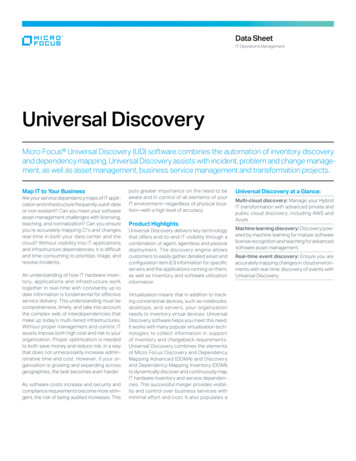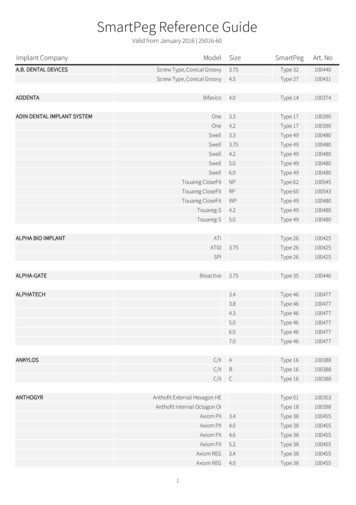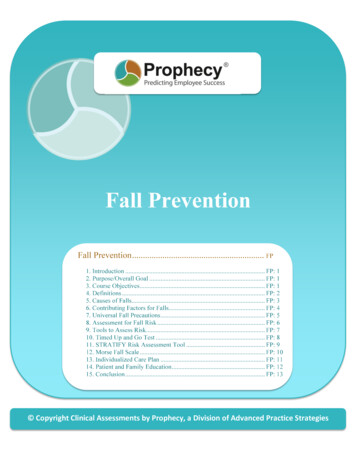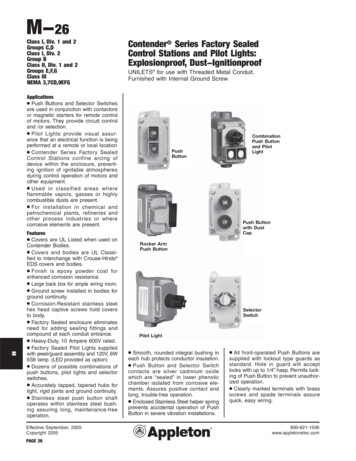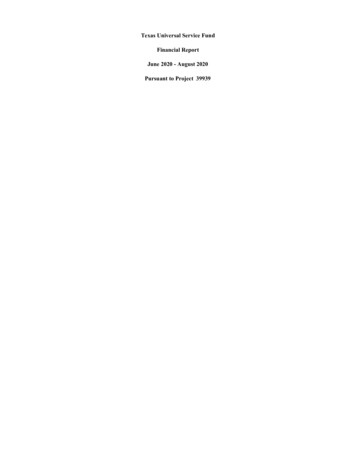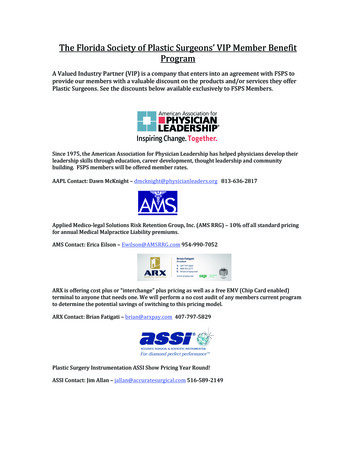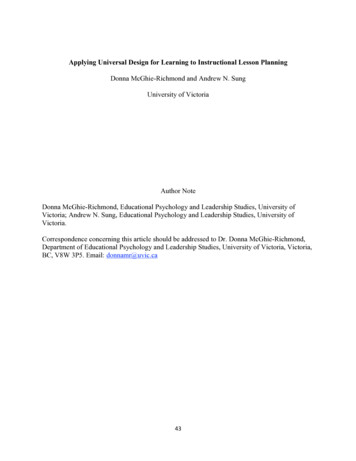
Transcription
Applying Universal Design for Learning to Instructional Lesson PlanningDonna McGhie-Richmond and Andrew N. SungUniversity of VictoriaAuthor NoteDonna McGhie-Richmond, Educational Psychology and Leadership Studies, University ofVictoria; Andrew N. Sung, Educational Psychology and Leadership Studies, University ofVictoria.Correspondence concerning this article should be addressed to Dr. Donna McGhie-Richmond,Department of Educational Psychology and Leadership Studies, University of Victoria, Victoria,BC, V8W 3P5. Email: donnamr@uvic.ca43
AbstractUniversal Design for Learning is a framework for developing inclusive instructional lessonplans. The effects of introducing Universal Design for Learning Principles and Guidelines in auniversity teacher education program with pre-service and practicing teachers were explored in amixed methods approach. The results indicate that the study participants made significantchanges to their lesson plans to optimally include all students. The participants expressedprofound changes in understanding inclusion and instructional roles and responsibilities.Keywords: Universal Design for Learning, inclusion, teacher education, instructionallesson planning44
IntroductionWalk into any Canadian elementary, middle, or secondary level classroom today and youwill no doubt encounter a rich mosaic of students who exhibit a diverse range of capabilities,learning profiles, and interests. In Canadian schools the majority of students with special needsare educated in inclusive classrooms in their neighborhood schools where the general educationclassroom teacher takes responsibility for the learning of all students. Inclusion is therecommended teaching practice in Canadian schools and is supported by provincial educationalpolicy. In British Columbia, inclusion describes the principle that ‘all students are entitled toequitable access to learning, achievement and the pursuit of excellence in all aspects of theireducational programs’ (British Columbia Ministry of Education, 2011, p. 2). While inclusion inthe province is ‘not necessarily synonymous with full integration in regular classrooms’ (BritishColumbia Ministry of Education, 2011, p. 2), legislation emphasizes educating students withspecial needs in neighborhood schools with same age and grade peers to the fullest extentpossible.The Special Education Services: A Manual of Policies, Procedures and Guidelines(British Columbia Ministry of Education, 2011) outlines policies, procedures, and guidelines forthe delivery of special education services in British Columbia schools. Key student planningpolicies that are intended to facilitate inclusion of students who have special needs are included.Use of both instructional modifications and adaptations are clearly defined.Modifications are instructional and assessment-related decisions made toaccommodate a student’s educational needs that consist of individualized learninggoals and outcomes which are different than learning outcomes of a course orsubject. Modifications should be considered for those students whose specialneeds are such that they are unable to access the curriculum (i.e., students withlimited awareness of their surroundings, students with fragile mental/physicalhealth, students medically and cognitively/multiply challenged.) Using thestrategy of modifications for students not identified as special needs should be arare practice (British Columbia Ministry of Education, 2011, p. VI).Adaptations are teaching and assessment strategies especially designed toaccommodate a student’s needs so he or she can achieve the learning outcomes ofthe subject or course and to demonstrate mastery of concepts. Essentially,adaptations are “best practice” in teaching. A student working on learningoutcomes may be supported through use of adaptations. Adaptations do notrepresent unfair advantages to students. In fact, the opposite could be true. Ifappropriate adaptations are not used, students could be unfairly penalized forhaving learning differences, creating serious negative impacts to theirachievement and self-concept (British Columbia Ministry of Education, 2011,p. V).Modifications and adaptations are mandated for inclusive education in British Columbia.Yet, the two policies appear to be fundamentally divergent. Modifications emphasize specialeducation practices that are typically beyond the regular grade level curriculum of the generalclassroom environment. Limiting the strategy to students with special needs, modifications43
create a dichotomy within the inclusive classroom to accommodate for students with specialneeds, but not for others. On the other hand, adaptations emphasize practices within the regularclassroom so that all students may achieve. Accommodating for diverse learning needs,adaptations encourage and unify a common community of classroom learners.Meo (2008) argues that the traditional categorization of students as either ‘regular’ or‘special’ is erroneous and oversimplifies and inaccurately represents the diversity present intoday’s classrooms. Indeed, a global shift in understanding disability is occurring, as evident inthe World Health Organization’s (2006) revised definition of disability:Disability results from the interaction between persons with impairments andattitudinal and environmental barriers that hinder their full and effectiveparticipation in society on an equal basis with others (Convention on the Rights ofPersons with tion/conventionfull.shtml)The inclusive paradigm shift reconstructs disability away from individual pathology and into alens of social construction. The new definition recognizes the interaction between student,learning environment, and curriculum. Inclusion “relates not just to access but to active andproductive involvement” of students with special needs in general education classrooms(Bennett, 2009, p. 2). Yet, within this reconceptualization lays challenges. Even when placed inregular education classrooms, many students with special needs do not fully participate in theacademic or social life of the classroom. They frequently experience a separate space and aspecial program; reinforced by working solely with an educational assistant (Giangreco, 2010).Universal Design for Learning FrameworkUniversal Design for Learning (Meyer & Rose, 2000; Rose & Meyer, 2002) holdspromise for proactively planning curriculum and instruction that actively engages all studentscollectively. Universal Design for Learning arose from the concept of Universal Design withinthe field of architecture (Centre for Applied Special Technology; CAST, 1998). The term wasapplied to the idea of designing and creating new structures and public places in a way that wasaccessible to all from the beginning (Mace, 1998). Examples of Universal Design that havebecome commonplace and a benefit to all include curb cuts, automatic doors, and building ramps(Bernacchio & Mullen, 2007; Gargiulo & Metcalf, 2013; Pisha & Coyne, 2001). UniversalDesign holds that everyday items are designed to be useful to a variety of users. Other examplesinclude word processing software, closed captioning on video displays, and symbols representingwashrooms and other common facilities that provide access to the widest range of users possible.Adopted by education, Universal Design for Learning extends to the development ofcurriculum and instruction. Universal Design for Learning is a “blueprint for creating flexiblegoals, methods, materials, and assessments that work for everyone (CAST, 1998, paragraph 2).The concept of Universal Design for Learning is based on research in the learning sciences (e.g.,education, developmental psychology, cognitive neuroscience) and extends the notion ofUniversal Design in architecture by providing a framework that guides the design of flexibleeducational environments, materials, and instruction, to ensure that all students can access thecurriculum (Rose, Gravel, & Domings, 2010; Rose, Meyer, & Hitchcock, 2005). As Meyer &Rose (2000) contend, educators who design their learning methods for the “divergent needs of44
‘special’ populations increase usability for everyone” (p. 39). In addition to increased access andusability, embedding Universal Design for Learning into curricula and materials can be expectedto improve outcomes for all learners (Pisha & Coyne, 2001).As displayed in Figure 1, several principles and guidelines underpin the Universal Designfor Learning educational framework. These principles and guidelines acknowledge that learnerdiversity is to be expected in the classroom and support teachers to proactively plan for thisdiversity at the development stage of instructional unit and lesson planning. Moving away from aone-size-fits-all curriculum and instruction model towards a diverse and inclusive model,Universal Design for Learning provides a framework for developing “best practice” instructionaladaptations as defined by the British Columbia Ministry of Education (2011). With principlesand guidelines that operationalize instructional planning for the benefit of all students, UniversalDesign for Learning is garnering increased attention in British Columbia school districts andsome teacher education programs.Teacher education programs are key players in preparing prospective teachers to teach indiverse classrooms. In British Columbia all pre-service teachers are required to undertake acourse in special education as part of their qualification for a Bachelor of Education degree. Theinstructional focus of this overview course is typically on the provincial policies, procedures, andinstructional approaches, strategies and materials that support students in inclusive classrooms.Universal Design for Learning may or may not be a focus of the course.While some studies suggest experienced teachers are unable to retrofit instruction forstudents with special needs due to lack of training, time constraints, classroom management, andstudent levels (Cawley et al., 2004; Schumm & Vaughn, 1995); one study from a teachereducation program suggests pre-service teachers can develop lesson plans accessible to alldiverse learners when they are trained in Universal Design for Learning (Spooner, Baker, Harris,Ahlgrim-Delzell, & Browder, 2007). The participants in the Spooner et al. (2007) study includedgraduate and undergraduate students enrolled in education classes. Those in the interventiongroup received intensive one hour-long instruction in Universal Design for Learning and wereprovided with 20 minutes to draft a classroom lesson plan that would address the learning needsof a student with an identified special need who was presented in a case study format. Those inthe control group completed the lesson plan activity without Universal Design for Learninginstruction. Utilizing a scoring rubric designed by the authors, significant pre-post differences inapplying Universal Design for Learning principles were found between the intervention andcontrol groups. The Spooner et al. (2007) results highlight that a simple introduction to UniversalDesign can go a long way in helping teachers design lesson plans that include a range of learnersfrom the very start. Yet, participants in the Spooner et al. (2007) study expressed that additionaltime was needed to develop more detailed lesson plans. The researchers suggested future studiesshould examine the effects of allowing more time on Universal Design for Learning lesson plandevelopment.PurposeNo further study has examined the effects of introducing Universal Design for Learningin a teacher education program. An opportunity to do so arose from analyzing assignmentscompleted by pre-service and practicing teachers participating in inclusive education coursesinstructed by the first author. The present study expands on the Spooner et al. (2007) research byproviding pre service teachers with an extended opportunity to redesign instructional lessonplans according to Universal Design for Learning. Lesson plans were redesigned following a45
brief introduction to Universal Design for Learning. As researchers, we wished to exploreUniversal Design for Learning as a framework for developing instructional adaptations thatoptimally support all students in inclusive education classes. The revised lesson plans andreflections were analyzed using the following research questions as a guide:1. What were the types of changes made to previously taught lesson plans after applyingUniversal Design for Learning?2. What connections did the participants make between the process of applying UniversalDesign for Learning to lesson planning and what they learned as a result?3.MethodParticipantsThe study took place in the Faculty of Education at a mid-size university in WesternCanada. The study participants comprised two groups: pre-service teachers and practicingteachers. Pre-service teachers were sixteen undergraduate students studying to become secondarylevel (i.e., grades 9-12) teachers. Pre-service participants were enrolled in a 36-hour introductorycourse focused on assistive technology applications in diverse and inclusive classrooms. Thecourse was one of four in a summer institute students were undertaking for credit towards theirBachelor of Education degree. All pre-service teachers had some, albeit limited, prior teachingexperience in an earlier teaching practicum.Ten practicing teachers were undertaking a four-course, online post-degree certificateprogram in Special Education. These participants were enrolled in the first course of theprogram, focused on instructional approaches, strategies, and issues relative to teaching studentswith special needs in inclusive classrooms. The practicing teachers had broad rangingprofessional experiences, teaching across grade levels from K-11 and in a variety of rural, urbanand international school settings.ProcedureAs part of their coursework, the participants undertook an assignment where theyreviewed and revised a previously taught lesson plan through the lens of Universal Design forLearning. The assignment supported several course learning outcomes: (1) recognizing diversityin the classroom, (2) understanding barriers that are experienced by students who have learningdifferences and needs, and (3) addressing barriers to student participation by applying UniversalDesign for Learning principles to instructional planning. The participants received a briefintroduction to Universal Design principles and guidelines. The assignment was carefullydesigned by the instructor to support students’ independent discovery of how Universal Designfor Learning principles might be applied to lesson planning. The participants were asked to firstconsider the range of students in their classroom who have different learning needs according toan instructor-prepared ‘Wheel of Human Ability and Disability’. The wheel (see Figure 2)illustrates the following human dimensions that can impact learning: cognitive/intellectual,behavioral, hearing, physical/health, physical/motor, communication, vision, and emotional. Theparticipants then reviewed a YouTube video introducing them to the Universal Design forLearning principles of multiple means of representation, engagement, and expression(http://www.youtube.com/user/UDLCAST). The participants were directed to explore theNational Center on Universal Design for Learning46
(http://www.udlcenter.org/implementation/examples) for additional lesson plan templates. Theywere directed to sample lesson plans that follow a Universal Design for Learning framework(Rose, Gravel, & Domings, 2010). The center’s website provides multiple insights,considerations, and examples of how each Universal Design for Learning principle and guidelineis considered and incorporated into lesson planning to ensure all students are able to access andparticipate in the regular curriculum.The participants selected their own previously taught lesson plans from their curriculumareas of expertise (i.e., language arts, math, science, social studies). Referring to the UniversalDesign for Learning principles and guidelines, the participants critiqued their prior lesson plansand re-developed new ones to include wide ranging learning needs of all students in theclassroom. A Universal Design for Learning document outlining each principle and guidelinewas provided (see Appendix A). Included on this document was space for participants to writenotes, critique, and provide evidence for considering diverse learning needs (according to theWheel of Ability and Disability) and each Universal Design for Learning principle and guideline.The participants were asked to provide a brief (i.e., 1-2 page) reflection on the critique processand their learning relative to the learning outcomes of the assignment. The following componentswere submitted in their completed assignments:1. Original lesson2. Revised Lesson includinga. Recognition of diverse student learning needs through consideration of the Wheelof Ability and Disability;b. Identification of lesson plan components that were added / deleted; andc. Evidence for utilizing each Universal Design for Learning Principle as applicable3. Brief, 1-2 page reflection on the lesson plan redesign. Participants were required to:a. articulate changes made in lesson plans in light of Universal Design for Learningtraining;b. describe how they learned to apply Universal Design for Learning; andc. reflect on any connections they made between the lesson plan critique processand what they learned as a result.d.Data AnalysisThe ResearchersCommunity-based researchers note advantages of conducting research as insiders withinthe community (Brodsky & Faryal, 2006; Dalton, Elias, & Wandersman, 2001). Both authors arecareer educators with extensive experience in classrooms. The first author has thirty yearsexperience as: a special education teacher and consultant working with children and youth withsignificant and complex disabilities, a teacher educator, and a researcher. The second author hasseven years experience as a special education teacher supporting students with autism and iscurrently working towards a Ph.D in Educational Psychology. Insider knowledge of the everydayclassroom context and challenges faced by teachers is key to the mixed methods analysis of thisUniversal Design for Learning case study.47
Data Analysis ProceduresThe authors conducted an initial review of the participant assignments. Overall, theparticipants demonstrated the ability to redesign lesson plans incorporating Universal Design forLearning principles and guidelines. From these initial observations, a systematic processincorporating quantitative and qualitative analyses was developed.Quantitative AnalysisChanges that were made to the lessons were identified and categorized. Elements ofUniversal Design for Learning in the original lessons were not examined. Rather, only thosechanges arising from the assignment were analyzed. A codebook was created using MicrosoftExcel and a deductive method was used for categorizing the Universal Design for Learningchanges. Universal Design for Learning revisions were systematically quantified andcategorized; first into themes and then subthemes guided by the existing Universal Design forLearning principles and guidelines. The following questions guided the coding process. “Doesthis change represent the theme of multiple means of representation, perception, or expression?”And then, “given the deduced Universal Design for Learning theme, which correspondingUniversal Design subtheme does this change best reflect? (i.e., given the theme multiple meansof representation, does the change reflect increased perception, language, or comprehension)”?The data analysis codebook was analyzed comparing pre-service (n 16) to practicing teacher (n 10) participants. Clustered bar charts were created using Predictive Analytics SoftWare(PASW), Version 18.Qualitative AnalysisConnections made between the process of applying Universal Design for Learning andwhat was learned were identified and coded. The participants’ assignment reflections wereanalyzed. A codebook was created using Microsoft Excel and an inductive method was adoptedfor thematic analysis. Coding was based on knowledge of Universal Design for Learning asinsider members of the education community. First, each participant reflection was read in itsentirety. Then, connections were identified between the process of applying Universal Designand what the participants learned as a result. Connections were coded to optimally capturemeaning. The coding approach was a cyclical process. Codes were identified, changed andevolved over time (Saldaña, 2009). Both authors examined a number of reflections together andthought aloud to reach agreement. “What does this mean?” The critical task was to best interpretwhat the participants were trying to convey.ResultsQuantitative ResultsThe total number of changes made to previously taught lesson plans by Universal Designfor Learning themes and subthemes are displayed in Figure 3. Pre-service teachers made anoticeably greater number of changes than the practicing teachers in the Universal Design forLearning principle, multiple means of expression (under the guideline, provide options forcomprehension). However, no overall trend of group differences was observed. It is important to48
note that due to unequal sized groups, interpretation from comparing the total number of changesmade by pre-service versus practicing teachers is limited.These results initiated further interest in determining the total number of teachers whohad made such changes. A second clustered bar chart was created using PASW software. Figure4 displays the number of pre-service and practicing teachers who made changes to lesson plansaccording to Universal Design for Learning principles and guidelines. Most practicing teachersmade changes to their lessons according to each principle and guideline. Pre-service teachersrevised lessons in each principle and guideline as well. It was notable that fewer pre-serviceteachers made changes in the Universal Design for Learning principle, multiple means ofrepresentation (under the guideline, provide options for language, mathematical expressions, andsymbols). As well, pre-service teachers made fewer revisions than practicing teachers in theUniversal Design for Learning principle, multiple means of engagement (under the guideline,provide options for self-regulation).Qualitative ResultsThe teacher reflections from the assignment revealed two main themes; learning for alland transformative practice. The themes capture the impact and effect of Universal Design onparticipants’ learning.Learning for all. This theme is fundamentally student driven. It describes teachers usingUniversal Design for Learning to respond to the full range of student diversity in the classroom.One participant summed it up as follows:I must say that I have learned a great deal in the last week and am now aware ofhow to create instructional goals, methods, materials, and assessments that workfor an enormously broader group of students compared to my original planning(Pre-Service Teacher 10).Learning for all is an umbrella theme describing teacher efforts to reduce studentbarriers, focus on strengths, and consider learner preferences/characteristics. Consider thefollowing reflection in which the participant recognized the limitations of the curriculum itself interms of narrowly defining students’ learning outcomes:So I began to think of ways students could create/compose a story withouthandwriting. My thoughts developed like this – tell it orally and have someonescribe it (possibly, if there are enough people to scribe), have the students type iton the computer (but what if they physically could not use the keypad or don’thave the typing skills?), then possibly acquire the software for speech-to-text or amouse camera. There are so many possibilities! Didn’t Jean-Dominique Baubycompose his book with a blink of an eye? I am sure he applied all of the 6 traits ofwriting in his novel. I immediately made my first change to the lesson plan –‘writing’ became ‘composing’ (Practicing Teacher 2).Learning for all inspires passion for inclusion as evident in the following reflection:49
I want to think of absolutely everything, every child, every possibility. Hmm, asweird as it is, tears just came to my eyes as I wrote that – I want education to beaccessible and possible for every student; I want to give them as many tools as Ican for their learning to come in different ways; and I want to allow them manypossibilities of how to work with and show what they are learning (Pre-ServiceTeacher 14).Learning for all encourages best practice instructional adaptations that can benefit allstudents, rather than instructional modifications that solely address students with special needs.Through the process of applying Universal Design for Learning principles and guidelines, oneparticipant articulated that the framework provides “a base foundation that is intended for allstudents” (Pre-Service Teacher 9). More students spoke to the instructional enrichment gainedthrough a Universal Design lesson plan approach:The end result is an opportunity for students to grapple with concepts that are farmore meaningful, abstract and challenging than any that were touched upon bythe original lesson (Practicing Teacher 8).Thus, we learn from teachers themselves that Universal Design extends beyond lessonplanning for inclusive criteria – it creates curriculum and instruction that is far more challengingand meaningful - learning for all:The most surprising thing I have learned is that teachers who are effective at includingstudents with special needs in their classrooms are likely to be superior teachers for alltheir students (Practicing Teacher 5).Transformative practice. This second theme is fundamentally teacher focused. It is aboutteachers embracing Universal Design for Learning to improve their professional practice. Oneparticipant described new personal value in applying Universal Design in the classroom.It was a great learning experience and I hope that this skill of applyingUniversal Design for Learning to my lesson will be one that will eventuallybecome second nature to me. There seems to be an endless amount of value inaddressing all needs of all students in the class (Pre-Service Teacher 15)!Another participant reflected on the significance of adapting Universal Design for Learning intoteaching practice as below:In the beginning it can be more work for the teacher, but as it becomes anatural process, Universal Design lesson planning will be the best thing that everhappened, and you won’t even remember any other way (Practicing Teacher 10).Transformative practice through the adoption of Universal Design for Learningchallenges prior teaching and learning assumptions. For example, one participant was open andhonest in sharing her previous assessment philosophy:50
[Previously] I believed that it was necessary for students to adapt to myteaching— I saw my job as providing them with an option for meeting thelearning outcomes. If they couldn’t do it, then I should mark them accordingly—fair and square. If someone had told me I could make the lesson“universal,” I’m not sure I would have, or even could have, believed thatperson. I was teaching almost unconsciously—despite the best intentions,and a huge commitment to providing my students with what they needed,more than anything else, my instruction was informed by the way I myself hadbeen taught (Practicing Teacher 8).Transformative practice through Universal Design for Learning has broad implicationsfor teacher roles and responsibilities in the context of fostering inclusive classrooms. Considerthe connection made by one participant:I have learned that Universal Design requires constant reflection and review byeducators through collaboration, student feedback and individual assessment ofone’s own teaching practices (Practicing Teacher 3).As concluded by this participant, ‘Universal Design for Learning [as transformativepractice] can be understood as a way of thinking about teaching and learning rather than a set ofspecific instructional strategies that, if followed correctly, would establish an inclusiveclassroom’ (Pre-Service Teacher 1).DiscussionThe quantitative changes that participants made to their instructional lessons suggest thatUniversal Design for Learning provides teachers with a useful framework for developingadaptations for all learners. Both pre-service and practicing teachers made substantial changes ineach of the Universal Design for Learning Principles and Guidelines. From Figure 4, it isinteresting that when compared to practicing teachers, fewer pre-service teachers made lessonplan changes according to two critical Universal Design for Learning principles: multiple meansof representation and multiple means of engagement; under the guidelines of: provide options forlanguage, mathematical expressions, and symbols, and provide options for self regulation.Perhaps due to relative inexperience, they are less aware of the multitude of learning processesfundamental to teaching and learning success. Yet, for both pre-service and practicing teachers,the Universal Design for Learning framework supported them to develop numerous adaptationsthat were beneficial for all students in the classroom. Perception, expression, and comprehension- all critical learning processes – were operationalized to a greater extent throughout the revisedlesson plans. The study reveals that when provided with an opportunity, teachers are able toproactively make adaptations in their lesson plans that support learning for all.The qualitative themes that emerged in this study, learning for all and transformativepractice, indicate that Universal Design for Learning provides teachers with a useful model forachieving i
Universal Design for Learning is a framework for developing inclusive instructional lesson plans. The effects of introducing Universal Design for Learning Principles and Guidelines in a university teacher education program with pre-service and pract



